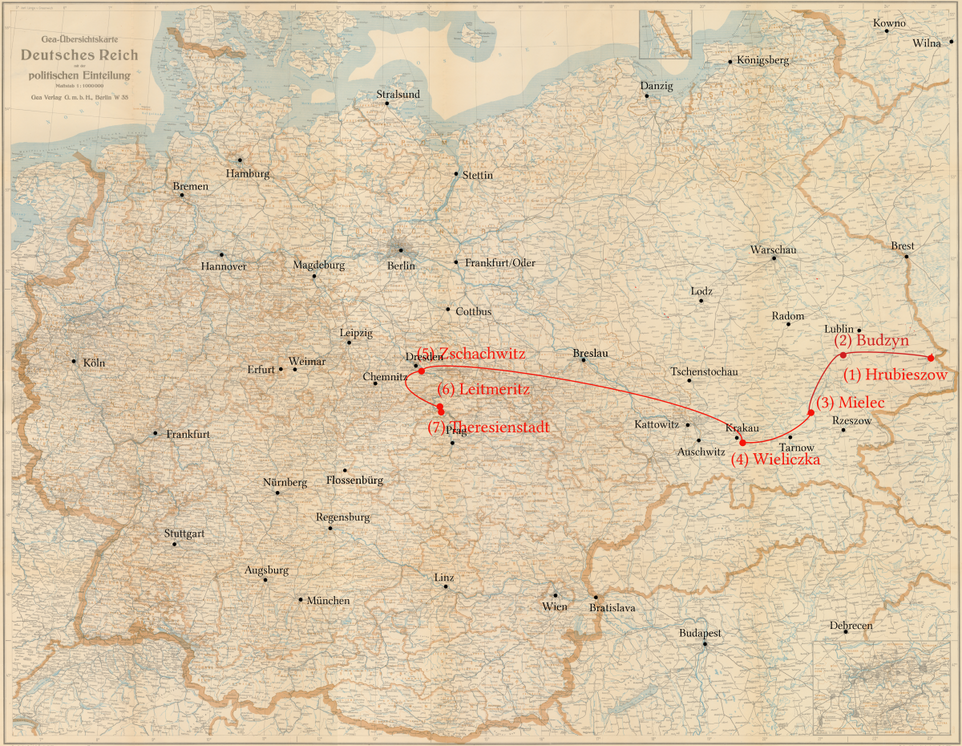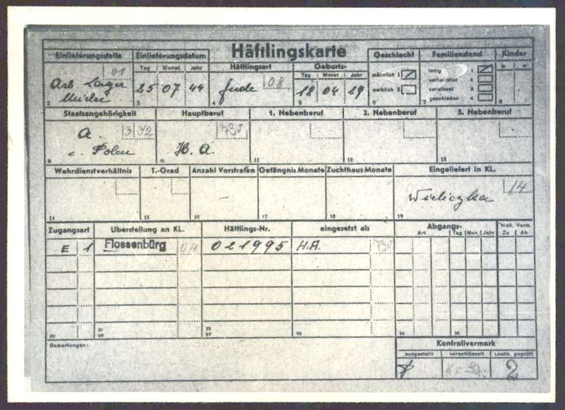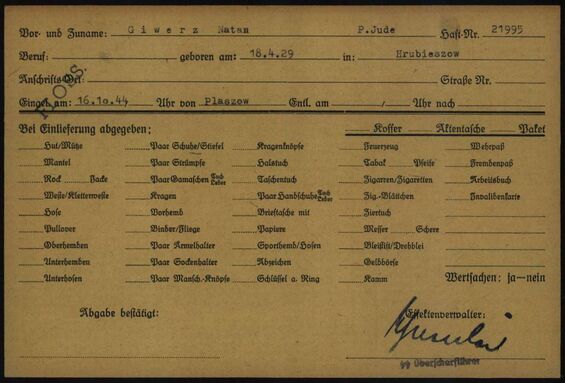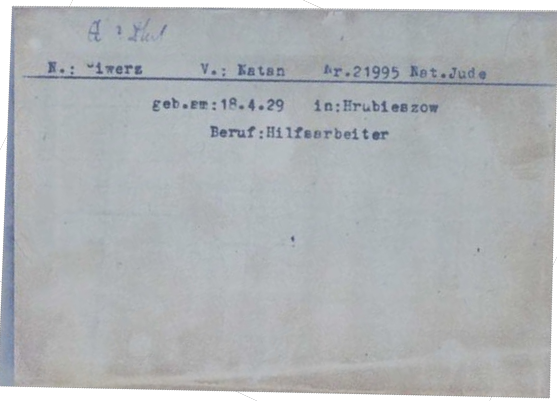Natan Gewürz
- Born on 18.4.1931 in Hrubieszow/Poland, died on 25.12.1974.
- 1939 to January 1943 Hrubieszow/Ghetto Hrubieszow
- January 1943 - February 1944 ZAL Budzyn (earthworks, tank traps)
- February 1944 to 25 July 1944 Plaszow/Mielec concentration camp (aircraft factory)
- 25 July 1944 to October 1944 Plaszow/Wieliczka concentration camp (salt mines)
- 16 October 1944 April 1945 Flossenbürg/Zschachwitz concentration camp (MIAG tank factory)
- Flossenbürg concentration camp/Leitmeritz subcamp
- Theresienstadt concentration camp
- 1 January1947 Displaced Persons Camp Jordanbad
- 24 Jsanuary 1947 Displaced Persons Camp Ulm
- 27 January 1947 Marseille/Frankreich
- Cyprus
- 9 November 1947 Israel
He was 8 years old when his persecution began.
Note: The dates in his affidavit do not match the information on prisoner documents and the information on the Flossenbürg concentration camp. The above dates are based on information from the article "Hrubieszow" on sztetl.org.pl, as well as information from THE UNITED STATES HOLOCAUST MEMORIAL MUSEUM (Ed), Encyclopedia of CAMPS AND GHETTOS, 1933-1945 VOLUME I, Part B (Mielec p. 869, Budzyn p. 882)
The order of the camps corresponds to the information in the literature.
Hrubieszow/Ghetto Hrubieszow
I was born on 16 April 1931 in Hrubieszow (Lublin district) as the son of Berko and his wife Frieda, née Hudis.
My family name used to be Giwerc and I remember that I was also registered under this name in the various camps and later DP camps.
In Palestine I called myself Gewürz because this name is easier to pronounce and more common.
At the beginning of 1940, the German Wehrmacht marched into Hrubieszow and soon after the invasion an order was issued that the Jewish inhabitants had to report for roll call. Those Jews who turned up for the roll call were later killed, including my father. After we learnt about this, we initially hid in our house. The Polish residents of the house gave us an ultimatum to hand ourselves in to the Gestapo within 6 hours. So we left the house and my mother and I hid inside the ghetto. Another brother who had turned himself in was taken to the ghetto by the Gestapo. This brother lives in America.
One night there was a check-up and the camp leader, an SS man called Wagner, checked himself and found us hiding in the ghetto. He ordered us to hand ourselves in at the camp leader's office the next day and when we turned ourselves in there the next day, a member of the Judenrat who was present at the hearing managed to influence the camp leader to send us to the ghetto too, even though both my mother and I were unfit for work.
Note: According to sztetl.org.pl and Encyclopedia of CAMPS AND GHETTOS, 1933-1945, VOLUME II, Ghettos in German-Occupied Eastern Europe, Part A, p. 634 ff
- the German army marched into Hrubieszow in 1939
- the ghetto was established in 1940
- Natan Gewürz was probably one of 200 Jewish prisoners who had to carry out clearing work after the liquidation of the ghetto in November 1942. They were deported to the forced labour camp in Budzyn in May 1943.
Mai 1943 - Februar 1944: ZAL/KZ Budzyn
I was in the ghetto until January 1941, when I was transferred to the Budzyn labour camp near Lublin. The Budzyn camp was in the Lublin district. The camp was surrounded by an electrified wire fence and there were also watchtowers where Ukrainian police kept watch. There were women, men and children in the camp and everyone was forced to work. We were given prisoner's clothes in this camp. We were also given numbers, but I can't remember my number. I was in this camp with my mother and my brother, whom I mentioned above. I initially had to do earthworks there, including digging trenches in which potatoes were then stored. Later I worked on the construction of anti-tank traps. We were accompanied to work by Ukrainian police. We worked in groups. Each group consisted of about 30-50 men, at times only men. We were guarded during the work and on the way to work and stopped at work. We were also beaten.
The food was particularly bad. We lived in barracks, about 150 men in each barrack. I can't remember the exact number of inmates in the camp, but it was in the thousands.
Anmerkung: Es wurden wurden Häftlinge aus Budzyn im Februar 1944 ff wegen zu geringer Auslastung nach Mielec verlegt (Encyclopedia of CAMPS AND GHETTOS, 1933–1945, VOLUME I, Early Camps, Youth Camps, and Concentration Camps and Subcamps under the SS-Business Administration Main Office (WVHA), Part B, S. 883).
| Zwangsarbeitslager für Juden im "Generalgouvernement" | |
|---|---|
| Ort | Budzyń |
| Gebiet | Generalgouvernement, Distrikt Lublin (1939-1944) |
| Eröffnung | April 1940 (erste Erwähnung) |
| Schließung | 22.10.1943 (letzte Erwähnung) Das Lager wurde als Außenlager des KZ Lublin-Majdanek weitergeführt. Im Juli 1944 "Evakuierung" in das Außenlager Radom, KZ Krakau-Plaszow, Außenlager Wieliczka und nach Starachowice |
| Geschlecht | Männer/Frauen |
| Einsatz der Häftlinge bei | Heinkel-Flugzeugwerke, Firma Beitler |
| Art der Arbeit | Instantsetzung von Maschinen |
| Quelle: deutschland-ein-denkmal.de | |
Februar 1944 bis 25.7.1944 KZ Plaszow/Mielec
There were men and women in Mielec, but the majority were men. I worked in an aeroplane factory in Mielec. They assembled all the parts for aeroplanes there, except for the engines. They worked there day and night and we had to work in shifts. The working day was 12 hours.
When asked about the name of the aircraft factory, I explained that I didn't know the specific name of the aircraft factory and we weren't told the name.
I also can't remember the name of the foreman I worked under.
The aircraft factory was not in the camp, but next to the camp and we had to walk to the workplace every day. But it wasn't far and we walked 5-10 minutes in total. Before we started we were counted and after we arrived at the workplace we were counted again. There was no supervision on the way itself.
| Außenlager des Konzentrationslagers Kraukau-Płaszów | |
|---|---|
| Ort | Mielec, Tarnów |
| Gebiet | Generalgouvernement, Distrikt Krakau (1939-1944) |
| Eröffnung | 12.06.1944, vorher Zwangsarbeitslager für Juden |
| Schließung | "Evakuierung" am 22.07.1944 in das Außenlager Wieliczka und das KZ Flossenbürg; August 1944 (letzte Erwähnung) |
| Geschlecht | Männer |
| Einsatz der Häftlinge bei | Heinkel-Flugzeugwerke |
| Quelle: deutschland-ein-denkmal.de | |
Juli 1944 - Oktober 1944: KZ Plaszow/Wielicka
At the beginning of 1942, I can't remember the exact date, I was sent to the Wieliczka concentration camp. Wieliczka is near Krakow. There were salt mines there and we had to do forced labour in the salt mines. There were about 50 people in each group. We worked there loading salt. The SS were in charge of this camp. But I can't remember any more names. I only know that it was an Untersturmführer. We were given 1/4 kg of bread, a small piece of margerine, a spoonful of jam and 1 litre of soup to eat.
I was in this camp until December 1942 and in December 1942 I was sent to Plaszow, where I stayed for about 2-3 months. In Plaszow I worked cleaning the camp.
16 April 1944 to end of April 1945 Flossenbürg concentration camp/Zschachwitz subcamp
Around March 1943, I was transferred to the Schachwitz concentration camp near Dresden. There we had to work in a tank factory. I worked there assembling tanks. Again, I can't remember the names of the camp leaders and foremen. There were not only Jewish inmates in this camp, but also German and Italian war criminals, Russian prisoners of war, Ukrainian and French prisoners of war and, as far as I remember, there were 500 - 600 Jews in total. We also wore prisoner's clothing here and had convict numbers, I can't remember the number.
| Subcamp of the Flossenbürg concentration camp | |
|---|---|
| Location | Zschachwitz near Dresden |
| Area | Saxony |
| Opening | 14 October 1944 |
| Closing | "Evacuation" on 15 April 1945 to Litomèrice (Leitmeritz) |
| Prisons | About 1,000 prisoners from the Krakow-Plazow and Mauthausen concentration camps |
| Gender | Men |
| Employment of the prisoners at | MIAG (Mühlen- und Industrie AG) |
| Type of work | Production of tanks |
| Source: germany-a-monument.de | |
April to May 1945 Leitmeritz and Theresienstadt
In April 1945, as the Russians approached, we were taken out of the camp, spent a day in the Leitmeritz camp and then arrived in Theresienstadt in April 1945.
We were no longer working in Theresienstadt and we were liberated by the Russians on 8 June 1945.
I am married and the father of one child.
After the War
After my liberation on 8 May 1945 in Theresienstadt, I first went to Lublin and stayed in a children's home there. I stayed in Lublin until September 1945 and then went from Lublin to Sosnowitz. In the children's home in Lublin, I joined a group that wanted to emigrate to Palestine and I went with this group first to Sosnowitz and from Sosnowitz to the various DP camps.
I left Sosnowitz in October 1945 and went to Germany, where we were in the Föhrenwald DP camp in November 1945. In January 1946 we went to the Leibheim DP camp and then in April 1946 to the DP camp in Jordanbad near Biberach.
We stayed in the Jordanbad DP camp until 24 January 1947 and from Jordanbad we went to Ulm for three days and from Ulm to France on 27 January to embark in a port near Marseille for emigration to Palestine.
I remember very clearly that I was registered in the DP camp at Jordanbad near Bibrach by a UNRRA official. There can be no doubt that I was in the Jordanbad DP camp on 1 January 1947. I am still together with the members of the group that emigrated to Palestine at that time and we have kept a diary of our experiences from liberation to immigration. In this diary, the date 24 January 1947 is noted as the date on which we left the Jordanbad DP camp.
We left France in March 1947. Our ship was caught by the British authorities and we were taken to Cyprus, where we arrived on 13 April 1947.
I stayed in Cyprus until November 1947 and entered Palestine on 9 November 1947.
notes
Further Sources
-----
Office for Compensation
Stuttgart 1964-1974
Notes
---
Picture Credits
- Personal file of GIWERZ, NATAN, born on 18-Apr-1929, 1.1.8/ 1.1.8.3/10871779/ITS Digital Archive, Arolsen Archives
- Personal file of GIWERZ, NATAN, born on 18-Apr-1929, 1.1.8/ 1.1.8.3/10871779/ITS Digital Archive, Arolsen Archives
- Personal file of GIWERZ, NATAN, born on 18-Apr-1929, 1.1.8/ 1.1.8.3/10871779/ITS Digital Archive, Arolsen Archives



